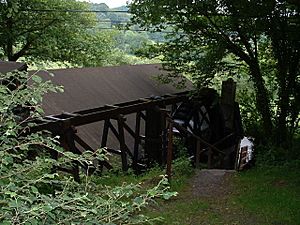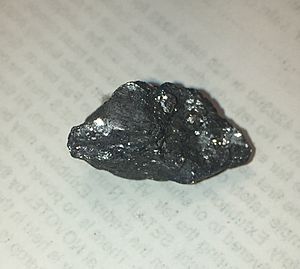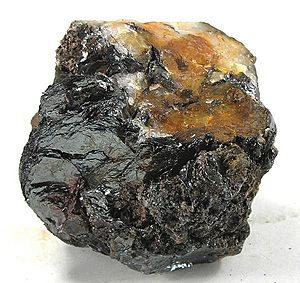Kelly Mine, Devon facts for kids
Kelly Mine is an old mine located on the edge of Dartmoor in Devon, England. It's near the village of Lustleigh. This mine was used to dig up a special kind of rock called micaceous haematite, also known as "shiny ore."
The mine worked on and off from the 1790s until 1951. It was one of several mines in the area that dug for this shiny ore. Since 1984, a group of volunteers has been working to fix up and preserve the mine.
Contents
What is Shiny Ore?
Micaceous haematite, or "shiny ore," is a flaky type of iron(III) oxide. Even though it's an iron ore, it wasn't used to make iron metal. Instead, it was very useful for making paint that stops rust.
As the world built more steel structures, like bridges and buildings, there was a big need for paint that could protect them. This demand helped some Devon mines, including Kelly Mine, keep working well into the 1900s. Today, similar paint is still made using this ore, though it comes from other countries.
The shiny ore from Kelly Mine was also sold as "Devonshire Sand." People used it like blotting paper to dry ink when writing.
At Lustleigh, where Kelly Mine is, there are three main rock veins that run from east to west. These veins can be up to about 1.2 metres (4 feet) wide.
History of Mining at Kelly Mine
Some studies of the waste rock at Kelly Mine suggest that people might have been digging for iron here for over 1,000 years!
The first official record of mining on this site is from a lease in the 1790s. Some work might have continued until the early 1870s.
In 1877, Kelly Mine was listed as an iron mine run by "The Kelly Iron Company." It reopened in 1879 and produced a small amount of haematite until 1891.
The mine then closed until 1900. After that, different companies ran it. The Scottish Silvoid Company operated it until 1917. Then, Ferrubron took over and ran the mine until 1946, when mining stopped completely. For a short time around 1950, another company used Kelly Mine's washing plant to treat ore from a nearby mine.
Kelly Mine never had many workers. For fifty years leading up to 1938, it usually had about six workers and rarely more than ten.
Saving and Restoring the Mine
Even though Kelly Mine was a smaller operation, it's very important today as a piece of industrial history. When the mine closed in 1951, the company that owned it owed money to the landowner. So, they left all the machinery behind. This equipment stayed mostly untouched for over thirty years.
In 1984, the landowner agreed to let a group of mining fans, now called the Kelly Mine Preservation Society (KMPS), take care of the site. This society is working hard to restore and protect the mine for future generations. They have fixed up the mine buildings and made the old machinery and processing plant work again.
Important Events at the Mine
Working in mines was often dangerous. On June 8, 1910, a mine worker named George William Druett, who was 28 years old, died in an accident at Kelly Mine. A wire rope broke, causing a cage full of ore to fall a long way down a shaft.
An investigation was held to find out what happened. The mine foreman said that the rope was not checked regularly, and there were no rules about workers standing under cages being lifted. The investigation decided it was an "accidental death." However, they recommended that the government should make mines like Kelly follow safety rules similar to those in coal mines. The mine owners agreed to new safety steps, including putting up a fence and making sure workers stood clear of the cages.
Three years later, another worker named John Johns died after a short illness. At the time, it was thought to be pneumonia. Later, it was believed he might have suffered from silicosis, a lung disease caused by breathing in dust from mining.




